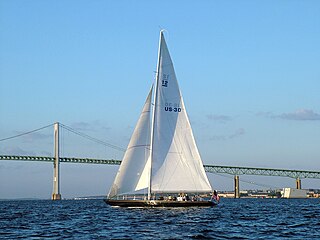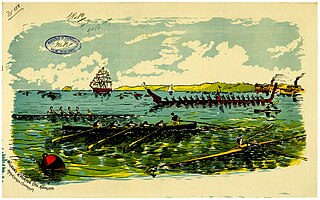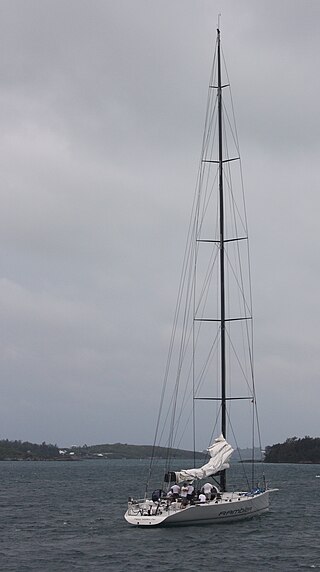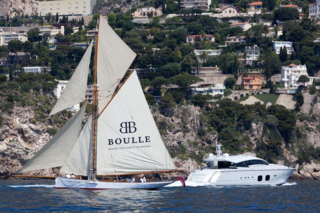
The America's Cup, informally known as the Auld Mug, is a trophy awarded in the sport of sailing. It is the oldest international competition still operating in any sport. America's Cup match races are held between two sailing yachts: one from the yacht club that currently holds the trophy and the other from the yacht club that is challenging for the cup. Matches are held several years apart on dates agreed between the defender and the challenger. There is no fixed schedule, but the races have generally been held every three to four years. The most recent America's Cup match took place in March 2021.
Bruce Kenneth Farr is a New Zealand designer of racing and cruising yachts. Farr‑designed boats have won, challenged for, or placed highly in the Whitbread Round the World Race, America's Cup, and Sydney to Hobart Yacht Race, among others.

Gipsy Moth IV is a 53 ft (16 m) ketch that Sir Francis Chichester commissioned specifically to sail single-handed around the globe, racing against the times set by the clipper ships of the 19th century.

The 12 Metre class is a rating class for racing sailboats that are designed to the International rule. It enables fair competition between boats that rate in the class whilst retaining the freedom to experiment with the details of their designs. The designation "12 Metre" does not refer to any single measurement on the boat, and is not referencing the vessels overall length, rather, measures the sum of the components directed by the formula which governs design and construction parameters. Typically 12 Metre class boats range from 65 to 75 feet in length overall; they are most often sloop-rigged, with masts roughly 85 feet tall.

Model yachting is the pastime of building and racing model yachts. It has always been customary for ship-builders to make a miniature model of the vessel under construction, which is in every respect a copy of the original on a small scale, whether steamship or sailing ship. There are fine collections to be seen at both general interest museums such as the Victoria and Albert Museum in London and at many specialized maritime museums worldwide. Many of these models are of exquisite workmanship, every rope, pulley or portion of the engine being faithfully reproduced. In the case of sailing yachts, these models were often pitted against each other on small bodies of water, and hence arose the modern pastime. It was soon seen that elaborate fittings and complicated rigging were a detriment to rapid handling, and that, on account of the comparatively stronger winds in which models were sailed, they needed a greater draught. For these reasons modern model yachts, which usually have fin keels, are of about 15% or 20% deeper draught than full-sized vessels, while rigging and fittings have been reduced to absolute simplicity. This applies to models built for racing and not to elaborate copies of steamers and ships, made only for show or for " toy cruising."

Ronald John Holland is a yacht designer, who came to prominence in the 1970s with his successful racing designs, and is now best known for his superyachts such as Mirabella V and Ethereal. He is now based in Vancouver, British Columbia, Canada.

Christopher Stuart Dickson is a sailor from New Zealand. He was world youth champion three years in succession and later became world match race champion three times. He also skippered several yachts in America's Cup racing, and for New Zealand at the 2000 Summer Olympics, and in numerous other sailing competitions.

The first Auckland Anniversary Regatta took place in 1840 and has grown to become one of the largest single day regattas and is the oldest sporting event in New Zealand. As a yachting event it pre-dates the America's Cup by 11 years.
Archibald Arch Logan was a New Zealand sailing yacht designer who was a leading figure in New Zealand yachting from approximately 1895 until his death. The Arch Logan Memorial Trophy named in his honour is the premier trophy of the New Zealand M class centreboard racing dinghy sailing completions.
Yachting New Zealand is recognised by World Sailing as the governing body for the sport of sailing in New Zealand. Yachting New Zealand also facilitates training in sailing in and around the country.
The JJ Giltinan International Trophy is considered the world's premier 18-foot skiff open championship, the eponymous brainchild of noted Australian sports entrepreneur J. J. Giltinan.
Robert Logan Senior (1837–1919) was a notable boat builder and the founder of the Logan boat building and boat designing dynasty.
Logan Brothers was a firm of boat and yacht design and builders. Although their Auckland yard lasted only from 1890 to 1910, it was the most significant yacht- and boat-building business in the Southern Hemisphere during its time, dominating the New Zealand market and exporting vessels to Australia, South Africa and to the Pacific Islands.

Ariki is a racing yacht which was built in Auckland, New Zealand in 1904 by Logan Brothers. She had a distinguished career as a racing and cruising yacht. From the time of her launch in Oct 1904 she dominated first class Auckland yacht racing until the appearance of the yacht Ranger in 1938. She has the sail number A3.

Alfa Romeo I is a 27.43-metre (90.0 ft) fixed keel maxi yacht, launched 2002, which placed first in the 2002 Sydney-Hobart race and the 2003 Giraglia Rolex cup regatta.
America II is a racing sailboat and one of the final America's Cup 12 Meters. There were a total of three America IIs commissioned for the New York Yacht Club's challenge in the 1987 America's Cup. These were US 42, 44 & 46 and all boats were named America II.
Greg Elliott is a New Zealand sailing yacht designer. He is most notable for the Elliott 6m, an Olympic-class keelboat selected for the women's match racing event for the 2012 Olympics.
Digby Fergusson Taylor was a New Zealand sailor who skippered yachts in both the 1981–82 and 1985–86 Whitbread Round the World Races.

Partridge is documented as being the world's oldest, still fully operational classic racing yacht.
Royal Suva Yacht Club is a Fijian yacht club, located in Walu Bay, Suva, Fiji.











